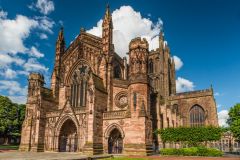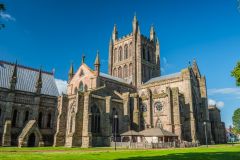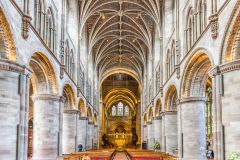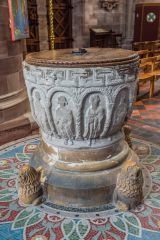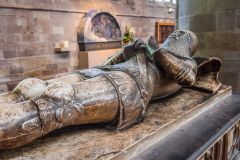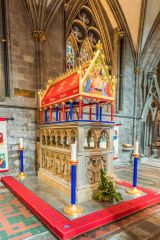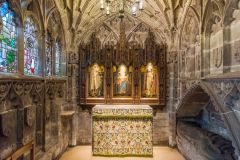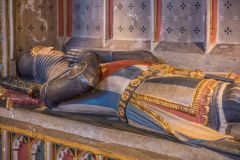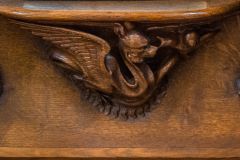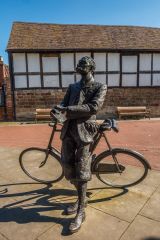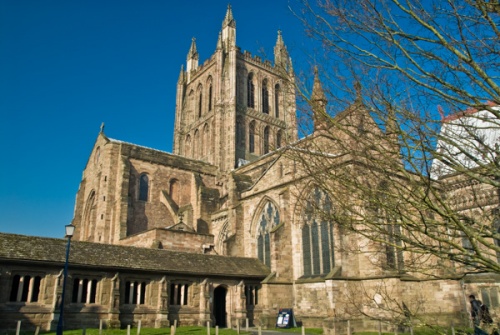
Never has such a delightful building arisen from a terrible murder. In the late 8th century, Ethelbert, king of East Anglia, travelled to Mercia to ask for the hand of Aelfrytha, daughter of the powerful Mercian king, Offa. Offa, or possibly his wife Cynefrith, had the young Ethelbert murdered, tradition says at Marden, five miles away from Hereford, on 20 May 794 AD.
Ethelbert was buried at Hereford, which had then been in existence for almost 200 years. His tomb is believed to have been sited to the east of the present high altar. Shortly after his death, miracles began to be reported at Ethelbert's shrine. Ethelbert was subsequently canonised, and pilgrims flocked to view his relics, including a tooth said to belong to him.
One of the effects of this popularity was that Hereford Cathedral was rebuilt in grand style. Despite the Norman rebuilding, much of earlier Saxon structure remains, including sections of the crypt, chapel, nave, and south transept. As for Ethelbert, his relics were burned or lost during a Welsh raid on Hereford in 1055.
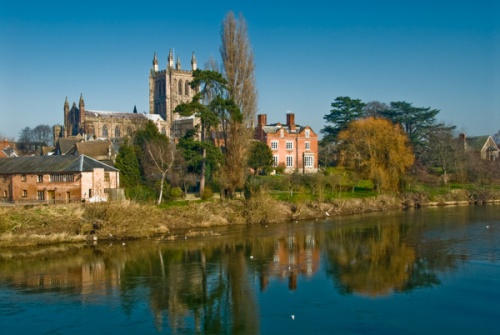
The superb Lady Chapel was added in 1217-25. This chapel features remarkable vaulting and slender, multi-layered columns which are extraordinarily well preserved. This is considered one of the best surviving examples of Early English architecture of any English cathedral. In the 16th century, the Lady Chapel was home to the Cathedral's chained library (see below), and marks made by the bookcases can still be seen.
The north transept is perhaps the most perfect example of Geometric Decorated Gothic style anywhere in Britain. This was the work of Bishop Peter Acquablanca (sometimes spelled 'Aigueblanche'). The arches of the triforium arcading are almost triangular; quite at odds with the earlier, softer lines of the south transept opposite.
Acquablanca is buried in the south transept, but more noteworthy than his tomb is that of Thomas de Cantelupe (St Thomas of Hereford). De Cantelupe was noted for a series of lawsuits brought against the Archbishop of Canterbury and against local barons. After his death in 1282 miracles were reported at his tomb. Like Ethelbert before him, Cantelupe was canonised, and a shrine erected in the north transept.
His shrine became so popular among his contemporaries for its alleged healing properties that King Edward I sent his falcons to the shrine to be healed. The top of Cantelupe's tomb has gone, but the base remains. About the base can be seen figures of Knights Templar, for Cantelupe was Grand Master of the Order in England during his lifetime.
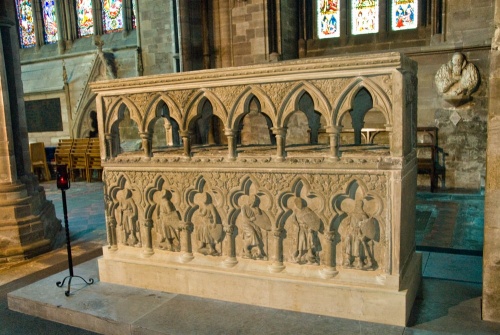
South Transept
This area of the cathedral was begun about 1107 and finished about 40 years later. The east wall is composed of five layers of arches, some of which are simply blind arcading. Within the south transept are a number of medieval brasses, some in quite an excellent condition.
The striking central tower was added to the cathedral in 1315. The decoration of this tower is exquisite, with rich carvings, and ball-flower ornamentation. The tower rises to 165 feet in height and can be climbed by visitors subject to opening times.
The treasures of the interior are many and varied. Among the most notable is the elaborate chapel of Bishop Edmund Audley (c. 1500). This vibrantly painted chapel is set into the south side of the Lady Chapel. Unusually, it is two stories high; the lower story contained the chapel proper, and the upper story a viewing chamber for overlooking the shrine of St Thomas of Hereford (no longer located in the Lady Chapel).
The Tudor screen of the chapel is said to be one of the finest in existence. The paint on the screen was preserved because for many years it was shielded from exposure by the bookcases of the chained library in the Lady Chapel. Within the Audley Chapel is a memorial to 17th-century poet and clergyman Thomas Traherne, a Hereford native.
To one side of the high altar is a carved wooden chair, believed to be the same one used by King Stephen when he visited the cathedral for the feast of Pentecost in 1138.
The lovely organ is Victorian and was restored in 1879 by Henry Willis (aka 'Father' Willis), and again in 1972 with funds from the Bulmer company (makers of cider) in whose honour a wooden woodpecker was sculpted on the side of the organ case.
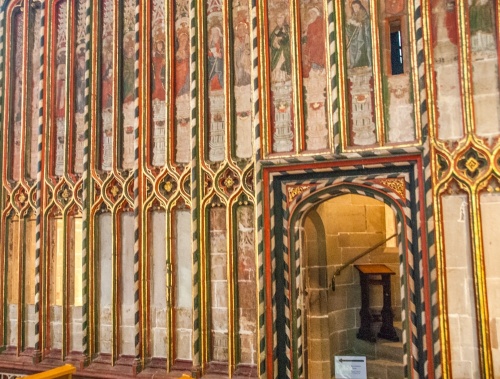
Between the north transept and the Lady Chapel is a lovely chantry chapel, built for John Stanbury, Bishop of Hereford from 1453 until 1474, and confessor to King Henry VI. This small chapel features exquisite vaulting in Perpendicular Gothic style. Bishop Stanbury's actual tomb stands just opposite his chapel.
The nave is extraordinarily light and airy, though the Romanesque columns give a sense of solidity at odds with the spaciousness of later building. The nave was originally one bay longer, but in 1786 the west tower of the cathedral collapsed, causing great damage. Architect James Wyatt was called in to repair the damage. Wyatt was generally successful, but he did shorten the nave and completely remodel the west front.
Mappa Mundi
One of the great treasures of Hereford Cathedral is the Mappa Mundi (Latin for 'World Map'). This map of the world was created sometime in the late 13th century, probably at Lincoln, by Richard of Haldingham. It measures about 64 x 52 inches and is drawn on a single sheet of vellum. It is one of the last known examples of an ecclesiastical map; that is, a map created from a religious perspective rather than a strictly geographical one. It shows Jerusalem at the centre of the world, and known (or supposed) geographic regions arranged about it.
The Chained Library
In the same section of the Cathedral that houses the Mappa Mundi is the Chained Library. This 16th-century library is the largest of its kind in existence. In the Middle Ages books were so rare, and so valuable, that they were often chained for safekeeping.
The Chained Library is a rare surviving example of this type of library. Among the manuscripts on display is a copy of the original Magna Carta of 1215, and the illuminated 8th-century manuscript known as the Hereford Gospels.
The Mappa Mundi and Chained Library are in the south cloister, accessed through the Cathedral Shop.
The Cathedral is located in the centre of Hereford, and there is ample paid and free parking close by. It is well worth a visit if you enjoy medieval architecture and history.
About Hereford Cathedral
Address: 5 College Cloisters, Cathedral Close, Hereford,
Herefordshire,
England, HR1 2NG
Attraction Type: Cathedral
Website: Hereford Cathedral
Email: office@herefordcathedral.org
Location
map
OS: SO511 397
Photo Credit: David Ross and Britain Express
HERITAGE
 We've 'tagged' this attraction information to help you find related historic attractions and learn more about major time periods mentioned.
We've 'tagged' this attraction information to help you find related historic attractions and learn more about major time periods mentioned.
Historic Time Periods:
Find other attractions tagged with:
13th century (Time Period) - Hereford (Place) - Saxon (Time Period) -
NEARBY HISTORIC ATTRACTIONS
Heritage Rated from 1- 5 (low to exceptional) on historic interest
St Ethelbert's Well - 0 miles (Historic Building) ![]()
Hereford Castle Pond - 0.1 miles (Castle) ![]()
Castle Green & Hereford Castle - 0.1 miles (Castle) ![]()
Hereford Town Hall - 0.1 miles (Historic Building) ![]()
Hereford, St Francis Xavier Church - 0.1 miles (Historic Church) ![]()
Hereford Museum and Art Gallery - 0.1 miles (Museum) ![]()
Hereford War Memorial - 0.2 miles (Historic Building) ![]()
Hereford, St Peter's Church - 0.2 miles (Historic Church) ![]()
